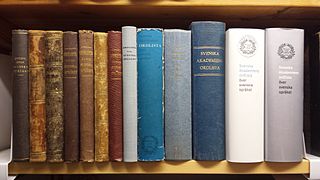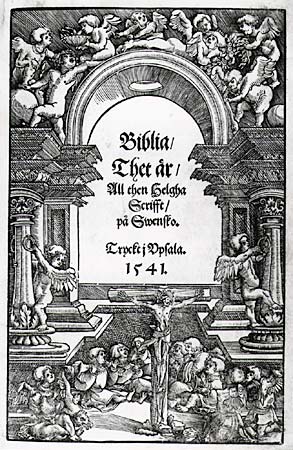In linguistics and specifically phonology, a phoneme is any set of similar phones that, within a given language, is perceptually regarded as a single distinct sound and helps distinguish one word from another.

Swedish is a North Germanic language from the Indo-European language family, spoken predominantly in Sweden and in parts of Finland. It has at least 10 million native speakers, the fourth most spoken Germanic language and the first among any other of its type in the Nordic countries overall.

Svenska Akademiens ordlista, abbreviated SAOL, is a spelling dictionary published every few years by the Swedish Academy. It is a single volume that is considered the final arbiter of Swedish spelling. Traditionally it carries the motto of the Swedish Academy, Snille och Smak, on its blue cloth cover.

The letter Å represents various sounds in several languages. It is a separate letter in Danish, Swedish, Norwegian, Finnish, North Frisian, Low Saxon, Transylvanian Saxon, Walloon, Chamorro, Lule Sami, Pite Sami, Skolt Sami, Southern Sami, Ume Sami, Pamirian languages, and Greenlandic alphabets. Additionally, it is part of the alphabets used for some Alemannic and Austro-Bavarian dialects of German.
The Danish and Norwegian alphabets is the set of symbols, forming a variant of the Latin alphabet, used for writing the Danish and Norwegian languages. It has consisted of the following 29 letters since 1917 (Norwegian) and 1948 (Danish):
The Swedish alphabet is a basic element of the Latin writing system used for the Swedish language. The 29 letters of this alphabet are the modern 26-letter basic Latin alphabet plus ⟨å⟩, ⟨ä⟩, and ⟨ö⟩, in that order. It contains 20 consonants and 9 vowels. The Latin alphabet was brought to Sweden along with the Christianization of the population, although runes continued in use throughout the first centuries of Christianity, even for ecclesiastic purposes, despite their traditional relation to the Old Norse religion. The runes underwent partial "latinization" in the Middle Ages, when the Latin alphabet was completely accepted as the Swedish script system, but runes still occurred, especially in the countryside, until the 18th century, and were used decoratively until mid 19th century.
A phonemic orthography is an orthography in which the graphemes correspond to the language's phonemes. Natural languages rarely have perfectly phonemic orthographies; a high degree of grapheme–phoneme correspondence can be expected in orthographies based on alphabetic writing systems, but they differ in how complete this correspondence is. English orthography, for example, is alphabetic but highly nonphonemic; it was once mostly phonemic during the Middle English stage, when the modern spellings originated, but spoken English changed rapidly while the orthography was much more stable, resulting in the modern nonphonemic situation. On the contrary the Albanian, Serbian/Croatian/Bosnian/Montenegrin, Romanian, Italian, Turkish, Spanish, Finnish, Czech, Latvian, Esperanto, Korean and Swahili orthographic systems come much closer to being consistent phonemic representations.

The sj-sound is a voiceless fricative phoneme found in the sound system of most dialects of Swedish. It has a variety of realisations, whose precise phonetic characterisation is a matter of debate, but which usually feature distinct labialization. The sound is represented in Swedish orthography by a number of spellings, including the digraph ⟨sj⟩ from which the common Swedish name for the sound is derived, as well as ⟨stj⟩, ⟨skj⟩, and ⟨sk⟩. The sound should not be confused with the Swedish tj-sound, often spelled ⟨tj⟩, ⟨kj⟩, or ⟨k⟩.
Swedish has a large vowel inventory, with nine vowels distinguished in quality and to some degree in quantity, making 18 vowel phonemes in most dialects. Another notable feature is the pitch accent, a development which it shares with Norwegian. Swedish pronunciation of most consonants is similar to that of other Germanic languages.
Swedish dialects are the various forms of the Swedish language, particularly those that differ considerably from Standard Swedish.

Modern Swedish is the linguistic term used for the Swedish language from the Bible translation of 1526 to the development of a common national language around 1880. The period can further be divided into Early Modern Swedish (1526–1750) and Late Modern Swedish (1750–1880).
Old Swedish is the name for two distinct stages of the Swedish language that were spoken in the Middle Ages: Early Old Swedish, spoken from about 1225 until about 1375, and Late Old Swedish, spoken from about 1375 until about 1526.
In the 9th century, Old Norse began to diverge into Old West Norse and Old East Norse. In the 12th century, the dialects of Denmark and Sweden began to diverge, becoming Old Danish and Old Swedish in the 13th century. All were heavily influenced by Middle Low German during the medieval period. Though stages of language development are never as sharply delimited as implied here, and should not be taken too literally, the system of subdivisions used in this article is the most commonly used by Swedish linguists and is used for the sake of practicality.
Swedish as a foreign language is studied by about 40,000 people worldwide at the university level and by over one million people on Duolingo. It is taught at over two hundred universities and colleges in 38 countries. Swedish is the Scandinavian language most studied abroad.

Finnish is a Uralic language of the Finnic branch, spoken by the majority of the population in Finland and by ethnic Finns outside of Finland. Finnish is one of the two official languages of Finland, alongside Swedish. In Sweden, both Finnish and Meänkieli are official minority languages. The Kven language, which like Meänkieli is mutually intelligible with Finnish, is spoken in the Norwegian counties Troms and Finnmark by a minority group of Finnish descent.
Danish orthography is the system and norms used for writing the Danish language, including spelling and punctuation.

Esaias Tegnér Jr. was a Swedish linguist. He was professor of eastern languages at Lund University 1879-1908, lead editor of Svenska Akademiens ordbok 1913-1919, member of the Bible Commission 1884-1917, and member of the Swedish Academy from 1882 onward. Tegnér was the grandson of the well-known poet Esaias Tegnér, also his namesake, and was brother-in-law to the poet and composer Alice Tegnér.
Värmländska refers to the indigenous speech varieties of the traditional Swedish province of Värmland. It is one of the dialects that form the group Götamål, as opposed to Sveamål, South Swedish dialects, Norrland dialects, Gutnish and Finland-Swedish dialects, in an often used classification of Swedish dialects.











